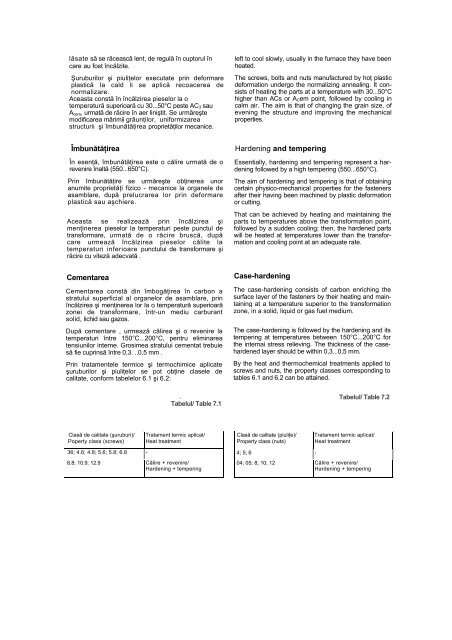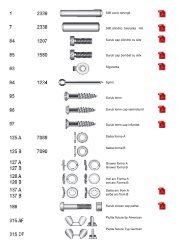Tratamente termice si termochimice aplicate organelor de asamblare
Tratamente termice si termochimice aplicate organelor de asamblare
Tratamente termice si termochimice aplicate organelor de asamblare
You also want an ePaper? Increase the reach of your titles
YUMPU automatically turns print PDFs into web optimized ePapers that Google loves.
lăsate să se răcească lent, <strong>de</strong> regulă în cuptorul în<br />
care au fost încălzite.<br />
Şuruburilor şi piuliţelor executate prin <strong>de</strong>formare<br />
plastică Ia cald li se aplică recoacerea <strong>de</strong><br />
normalizare.<br />
Aceasta constă în încălzirea pieselor la o<br />
temperatură superioară cu 30...50°C peste AC3 sau<br />
Acem, urmată <strong>de</strong> răcire în aer liniştit. Se urmăreşte<br />
modificarea mărimii grâunţilor, uniformizarea<br />
structurii şi îmbunătăţirea proprietăţilor mecanice.<br />
Îmbunătăţirea<br />
În esenţă, îmbunătăţirea este o călire urmată <strong>de</strong> o<br />
revenire înaltă (550...650°C).<br />
Prin îmbunătăţire se urmăreşte obţinerea unor<br />
anumite proprietăţi fizico - mecanice la organele <strong>de</strong><br />
<strong>asamblare</strong>, după prelucrarea lor prin <strong>de</strong>formare<br />
plastică sau aşchiere.<br />
Aceasta se realizează prin încălzirea şi<br />
menţinerea pieselor la temperaturi peste punctul <strong>de</strong><br />
transformare, urmată <strong>de</strong> o răcire bruscă, după<br />
care urmează încălzirea pieselor călite la<br />
temperaturi inferioare punctului <strong>de</strong> transformare şi<br />
răcire cu viteză a<strong>de</strong>cvată .<br />
Cementarea<br />
Cementarea constă din îmbogăţirea în carbon a<br />
stratului superficial al <strong>organelor</strong> <strong>de</strong> <strong>asamblare</strong>, prin<br />
încălzirea şi menţinerea lor la o temperatură superioară<br />
zonei <strong>de</strong> transformare, într-un mediu carburant<br />
solid, lichid sau gazos.<br />
După cementare , urmează călirea şi o revenire la<br />
temperaturi între 150°C...200°C, pentru eliminarea<br />
ten<strong>si</strong>unilor interne. Gro<strong>si</strong>mea stratului cementat trebuie<br />
să fie cuprinsă între 0,3. ..0,5 mm .<br />
Prin tratamentele <strong>termice</strong> şi <strong>termochimice</strong> <strong>aplicate</strong><br />
şuruburilor şi piuliţelor se pot obţine clasele <strong>de</strong><br />
calitate, conform tabelelor 6.1 şi 6.2:<br />
Clasâ <strong>de</strong> calitate (şuruburi)/<br />
Poperty class (screws)<br />
36; 4.6; 4.8; 5.6; 5.8; 6.8 -<br />
.<br />
Tabelul/ Table 7.1<br />
Tratament termic aplicat/<br />
Heat treatment<br />
8.8; 10.9; 12.9 Călire + revenire/<br />
Har<strong>de</strong>ning + tempering<br />
left to cool slowly, usually in the furnace they have been<br />
heated.<br />
The screws, bolts and nuts manufactured by hoţ plastic<br />
<strong>de</strong>formation un<strong>de</strong>rgo the normalizing annealing. It con<strong>si</strong>sts<br />
of heating the parts at a temperature with 30...50°C<br />
higher than ACs or ACem point, followed by cooling in<br />
calm air. The aim is that of changing the grain <strong>si</strong>ze, of<br />
evening the structure and improving the mechanical<br />
properties.<br />
Har<strong>de</strong>ning and tempering<br />
Essentially, har<strong>de</strong>ning and tempering represent a har<strong>de</strong>ning<br />
followed by a high tempering (550...650°C).<br />
The aim of har<strong>de</strong>ning and tempering is that of obtaining<br />
certain phy<strong>si</strong>co-mechanical properties for the fasteners<br />
after their having been machined by plastic <strong>de</strong>formation<br />
or cutting.<br />
That can be achieved by heating and maintaining the<br />
parts to temperatures above the transformation point,<br />
followed by a sud<strong>de</strong>n cooling; then, the har<strong>de</strong>ned parts<br />
will be heated at temperatures lower than the transformation<br />
and cooling point at an a<strong>de</strong>quate rate.<br />
Case-har<strong>de</strong>ning<br />
The case-har<strong>de</strong>ning con<strong>si</strong>sts of carbon enriching the<br />
surface layer of the fasteners by their heating and maintaining<br />
at a temperature superior to the transformation<br />
zone, in a solid, liquid or gas fuel medium.<br />
The case-har<strong>de</strong>ning is followed by the har<strong>de</strong>ning and its<br />
tempering at temperatures between 150°C...200°C for<br />
the internai stress relieving. The thickness of the casehar<strong>de</strong>ned<br />
layer should be within 0,3...0,5 mm.<br />
By the heat and thermochemical treatments applied to<br />
screws and nuts, the property classes corresponding to<br />
tables 6.1 and 6.2 can be attained.<br />
Clasă <strong>de</strong> calitate (piuliţe)/<br />
Property class (nuts)<br />
4; 5; 6 -<br />
Tabelul/ Table 7.2<br />
Tratament termic aplicat/<br />
Heat treatment<br />
04; 05; 8; 10; 12 Călire + revenire/<br />
Har<strong>de</strong>ning + tempering



